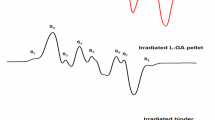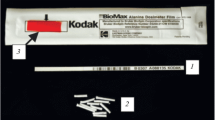Abstract
The performance characteristics of γ-rays dose measurements with EPR spectrometer and urotropine rods were analyzed, it were formulated as rods. The rods have significant signal that develops upon irradiation and the intensity of the signal increases with increasing absorbed radiation dose. It was observed that this material has a single EPR line. The detectable dose range was found to be 0 - 50 kGy. The dose response curves are linear up to 30 kGy. The influence of humidity, pre and post-irradiation storage under different conditions were investigated and determined.
Similar content being viewed by others
References
Gafar SM, El-Ahdal MA (2014) Dosimetric characteristics of 2,6 di-nitrophenol for high dose dosimetry. Dyes Pigm 109:67–71
Gafar SM, El-Ahdal MA (2015) A new developed radiochromic film for high-dose dosimetry applications. Dyes Pigm 114:273–277
Gafar SM, El-Ahdal MA (2016) Radiochromic fuchsine-gel and its possible use for low dosimetry applications. Adv Polym Technol 35(2):146–151
Gafar SM, El-Kelany MA, El-Ahdal MA, El-Shawadfy SR (2014) Toluidine blue O-gelatin gel dosimeter for radiation processing. Open J Polym Chem 4:56–61
El-Ahdal MA, Gafar SM, Emam MM, Saadany MR, Elokr MM (2014) Comparison between new (Gel/Liquid) dosimeter for radiation dosimetry applications. Int J Sci Eng Res 5:954– 959
Regulla DF, spectrometry ESR (2005) A future-oriented tool for dosimetry and dating. Appl Radiat Isot 62(2):117–127
Bradshaw WW, Cadena DG, Crawford GW, Spetzler HAW (1962) The use of alanine as a solid dosimeter. Rad Res 17:11–21
Regulla DF, Deffner U (1982) Dosimetry by ESR spectroscopy of alanine. Appl Radiat Isot 33:1101–1114
Sagstuen E, Sanderud A, Hole EO (2004) Review the solid-state radiation chemistry of simple amino acids, revisited. Radiat Res 162:112–119
Lund E, Gustafsson H, Danilczuk M, Sastry MD, Lund A, Vestad TA, Malinen E, Hole EO, Sagstuen E (2005) Formates and dithionates: sensitive EPR dosimeter materials for radiation therapy. Appl Radiat Isot 62:317–324
Sife-Eldeen KhA (2014) Factors affecting total dissolved solids concentration of γ-ray-irradiated aqueous hexamethylenetetramine solution: a dosimetric study. Phys Med 30:920–924
Abdel-Fattah AA, Ezz El-Din H, Abdel-Rehim F (2004) New alanine/EPR dosimeter using EVA copolymer/paraffin as a binder for high-dose radiation dosimetry: performance characterization. Int J Polym Mater 53:927–939
Acknowledgments
This work was financially supported by National Center for Radiation Research and Technology (NCRRT), Egyptian Atomic Energy Authority (EAEA), Nasr City, Cairo, Egypt for basic research in the field of radiation technology applications.
Author information
Authors and Affiliations
Corresponding author
Rights and permissions
About this article
Cite this article
Gafar, S.M., El-Kelany, M.A. Radiation Induced Free-Radicals for EPR Dosimetry Applications. Silicon 10, 2671–2675 (2018). https://doi.org/10.1007/s12633-018-9804-5
Received:
Accepted:
Published:
Issue Date:
DOI: https://doi.org/10.1007/s12633-018-9804-5




